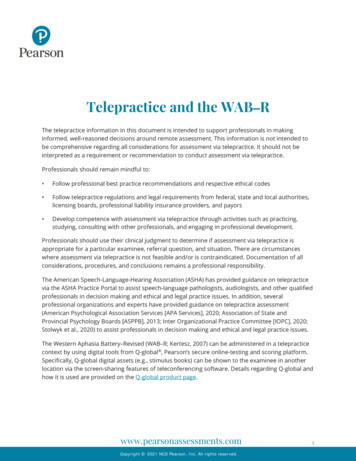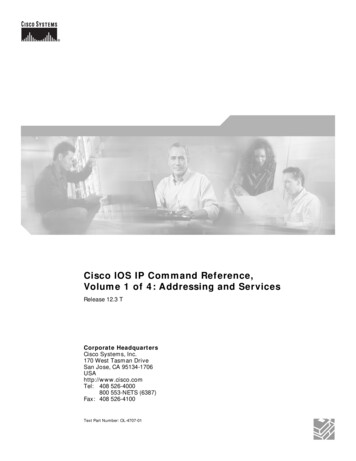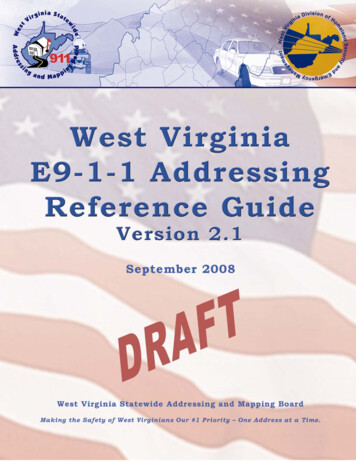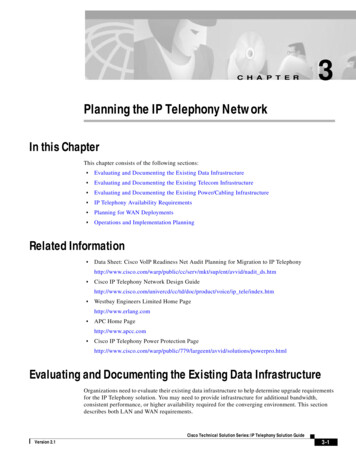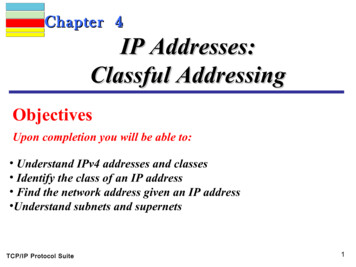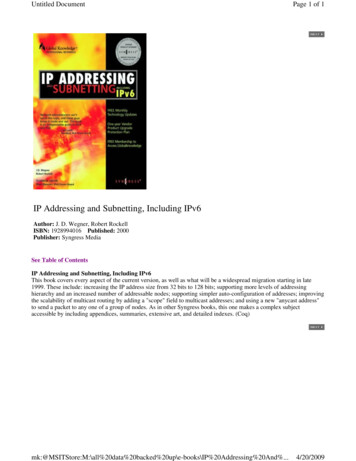
Transcription
Telepractice Going the Distance:Addressing Needs of Rural PublicSchoolsCarol C. Dudding, James Madison UniversityMichael Campbell , University of North Carolina atGreensboro.
Carol and Mike
Disclosure Financial interest:– Dudding and Campbellhave no financial interest Non-financial interest:– Campbell is current CEManager for SIG#18 onTelepractice, as well as thechair of the AmericanTelemedicine Association’s(ATA) Special InterestGroup on Telerehabilitation– Dudding is member ofASHA SIG 18 and ATATelerehab SIG member.
What we will share. Considerations for establishing telepracticewithin the public schools– Equipment and Infrastructure– Administrative– Clinical “telespeech” service delivery models Outcomes of two university-based programs Useful resources
Technical and Equipment Needs
DETERMINING EQUIPMENT ANDINFRASTRUCTURE NEEDSWhat do you want to be able to do?–––––Types of servicesSettingClients/patient needsDelivery modelSecurityWhat resources are available?– Equipment– Tech Support– Bandwidth/internetWhat are the costs?EquipmentTech support/ service agreementsBandwidth/internet
Levels of Digital VideoconferencingMobileDevices Tablets SmartphonesDesktop Webcam SoftwareSmallmeeting Dedicatedunit IntegratedTelepresence Highlyinteractive Immersive
Mobile Devices Smartphone/TabletAccessibilityAppsLimited control of video and audioquality Security/encryption
Desktop/Personal DVC WebcamLow bandwidth requirementsReadily available softwareMinimal equipment costsAccessibilityLimited control of video and audioquality No (limited) ability to control far camera view Security and encryption considerations
Small Meeting / Mid-level Dedicated digitalvideoconferencing equipment Moderate equipment costs Technical knowledge of firewalland internet technologies Higher bandwidth requirements Control of video and audio quality Control of far camera view Encryption and security
Telepresence Immersive High end technologies Advanced collaborationtools Network managementservices High cost 300,000
Peripherals
Software “Free” ware–––––Software SkypeYahoo MessengerWindows Live MessengerFacetimeJabberInteractive sites– Highlights for Kids– Scholastics for Kids– PBS Kids Commercial software––––Microsoft Office LiveAdobe ConnectElluminateVidyoFor a list of resources:MATRC – www.matrc.orgSLPs- Check out Judith Kuster’s html
Equipment Checklist DigitalvideoconferencingdeviceFormatCompatibility with otherdevices/peripheralsBandwidth requirements Monitor Sound system –microphones/soundcards Internet connectionAccessBandwidthSecurity PeripheralsDocument camerasScanners/printers/faxCartsMonitoring devicesCell phone
Administrative Considerations Security and Privacy Material and documentation sharing Licensure and Liability Reimbursement Ethical issues
PRIVACY & SECURITY Applicable Laws– FERPA (Family Educational Rights and Privacy Act)– HIPAA (Health Insurance Portability and Accountability Act of1996)– This document discusses how FERPA and HIPAA are c/ferpa-hipaaguidance.pdf Privacy – Policies and procedures must be kept up-to-date. Technology – Security considerations– Encryption – Does HIPAA require encryption?– Firewall protection– Records - Storage and sharing Recommended resource: Center for Telehealth and eHealth Law (CTEL)
Privacy and Internet-BasedTelepracticeEllen R. Cohn and Valerie J. M.WatzlafAbstractSpeech-language pathologists and audiologistshave historically been attuned to protecting theprivacy of their clients. The recent proliferation ofInternet-based communication for telepractice hasresulted in new and constantly evolving threats toclient privacy. This article provides an overview ofkey legal protections to privacy. With a focus onVoice over Internet Protocol (VoIP; e.g., Skype), theauthors present an approach to risk assessmentthat includes a HIPPA Compliance Checklist(Watzlaf, Moeini, & Firouzan, 2010) and a teamapproach to oversight. Upholding Internet-basedprivacy within the current environment is anongoing and challenging responsibility.Division 18 Telepractice : Perspectivesdoi: 10.1044/tele1.1.26 Perspectives on TelepracticeSeptember 2011 vol. 1 no. 1 26-37
CLIENT SELECTION Client Selection– “Any clinical service must beappropriate based on theunique needs of the client.Telepractice is notappropriate in allcircumstances, and a varietyof factors need to beconsidered.”– The need for physical contactmust be addressed.– SLP must assess if services areeffectiveFacilitators need to be welltrained.ASHA - TECHNICAL REPORT (2005
DOCUMENTATION Facilitator training SLP/Graduate clinician/CF training Informed Consent: Includes potential benefits and risks,use of telecommunications technology, presence offacilitator, possibility of recording (Fleisher & Dechene,2004) Notification: Acceptable in some states in place ofinformed consent Permission to video/audio record Properly document when a session is held by telepractice.
LICENSURE Practitioner must be licensed in thestate where the client/patient is locatedas well as the state where the SLP islocated. Logistical & financial disincentive Check with your State Boards ofExaminers See http://www.ncsb.info/state-regulations Proposed Interstate licensure models
REIMBURSEMENT Contract Services– Billing arrangement may vary(e.g., hourly, monthly) Third Party Reimbursement– Commercial Carriers– State agencies - Medicaid covers telepracticeservices in some states Grant Funding– Office for the Advancement of Telehealth (OAT)– U.S. Department of Education
ETHICAL CONSIDERATIONS Must not violate professional code of ethics Meet standards of care Demonstrate competence Informed consent Assure confidentialityAPA Tele-psychiatry draft guidelines posted July, 2012
ETHICAL CONSIDERATIONSASHA - CODE OF ETHICS (2010)THE FACILITATORo “Individuals who hold the Certificate of Clinical Competence shall notdelegate tasks that require the unique skills, knowledge, andjudgment that are within the scope of their profession to assistants,technicians, support personnel ”o “Individuals who hold the Certificate of Clinical Competence maydelegate tasks related to provision of clinical services to assistants,technicians, support personnel, or any other persons only if thoseservices are appropriately supervised, realizing that the responsibilityfor client welfare remains with the certified individual.”o “Individuals shall not misrepresent the credentials ofassistants support personnel ”
LIABILITY/MALPRACTICECONSIDERATIONS (FLEISHER & DECHENE, 2004) Does liability insurance provider covers telepracticeservices. Some recommend getting it in writing. Liability may also apply to telepractice consultations Standards of Care: Are there standards specific totelepractice & are they suitable for the student? Who is responsible for ––––student safety?equipment failure?training facilitator?notifying parents?
Clinical Models of ServiceDelivery
Service DeliveryAsynchronous Web-based Digital Videoconferencing Store-and-Forward ConsultationSynchronous
JMU Video incc/video/clip3.mp41. What equipment do you see beingutilized?2. What techniques did the clinicianemploy to encourage interaction?3. What did you see the assistant doingin the session?
JMU Equipment Two way interactive,high definitionvideoconferencingequipment Flat screentv/monitor Fax/copier/printer Therapy materials Document camera
JMU Lessons Learned Caseload selection Coordination of resources Start up investment Ways to enhance interactivity Importance of local personnel Value of meeting with family and administrators
UNCG Video Example
Lessons Learned Marketing– Needs dedicated time and effort– Should be ongoing– People need to see how telepractice works Communicating with school staff and parents at a distance– Email, phone calls, mail– Designated day/time to be available to school staff by video Room Design– Decoration: Minimal distractions; pale, solid-colored walls– Lighting: May need additional light source(s) in front ofchildren– Acoustics: Best to have room with some sound absorbingmaterial (e.g., carpet)– Size: Large enough for full IEP meeting and gross motoractivities– Location: Accessible throughout school
Useful Resources
www.asha.org/telepractice.ATA Telerehabilitation SIG
Helpful Links– ASHA Telepractice – American Telemedicine Association (ATA): http://www.atmeda.org– ATA Telerehabilitation Special Interest �� The Center for Telehealth & E-Health Law (CTeL) : http://www.ctel.org– Office for the Advancement of Telehealth (OAT):http://www.hrsa.gov/telehealth– Health Resources and Services Administration (HRSA):http://www.hrsa.gov– Telehealth Resource Center: http://www.cteconline.org/TRC.html– Universal Service Administration Company (USAC):http://www.usac.org– Appalachian Regional Commission (ARC): http://www.arc.gov– Agency for Health Care Research and Quality; http://www.ahrq.gov– Office of Rural Health Policy: http://www.ruralhealth.hrsa.gov
What’s yourdestination?
References ASHA. (2004). Training, Use, and Supervision of Support Personnel in SpeechLanguage Pathology [Position Statement]. Available fromwww.asha.org/policy.ASHA. (2005). Knowledge and Skills Needed by Speech-Language PathologistsProviding Clinical Services via Telepractice [Knowledge and Skills]. Availablefrom www.asha.org/policy.ASHA. (2005). Speech-Language Pathologists Providing Clinical Services viaTelepractice: Technical Report [Technical Report]. Available fromwww.asha.org/policy.ASHA. (2010). Professional Issues in Telepractice for Speech-LanguagePathologists [Professional Issues Statement]. Available fromwww.asha.org/policy.American Telemedicine Association. (2010). A blueprint for telerehabilitationguidelines. Available .cfm?pageID 3328Brown, J. (November, 2009). Telepractice ethics, reimbursement, and licensure.Available /2009/1445 Brown Janet.htm
References Crutchley, S. & Campbell, M. (2010). TeleSpeech Therapy pilot project:Stakeholder satisfaction. International Journal of Telerehabilitation. 2 (1).pp. 23-30. Fleisher, L. & Dechene, J. (2009). Telemedicine and e-health law. New York:Law Journal Press Grogan-Johnson, S., Alvares, R., Rowan, L., & Creaghead, N. (2010). A pilotstudy comparing the effectiveness of speech language therapy providedby telemedicine with conventional on-site therapy. Journal ofTelemedicine and Telecare, 16(3), 134-139. Grogan-Johnson, S., Gabel, R., Taylor, J., Rowan, L., Alvares, R. (2011). Apilot exploration of speech sound disorder intervention delivered bytelehealth to school-age children. International Journal ofTelerehabilitation, 3(1), 31-41.
ASHA SIG 18 and ATA Telerehab SIG member . . Does liability insurance provider covers telepractice services. Some recommend getting it in writing. . ASHA. (2010). Professional Issues in Telepractice for Speech-Language Pathologists [Professional Issues Statement]. Available from


